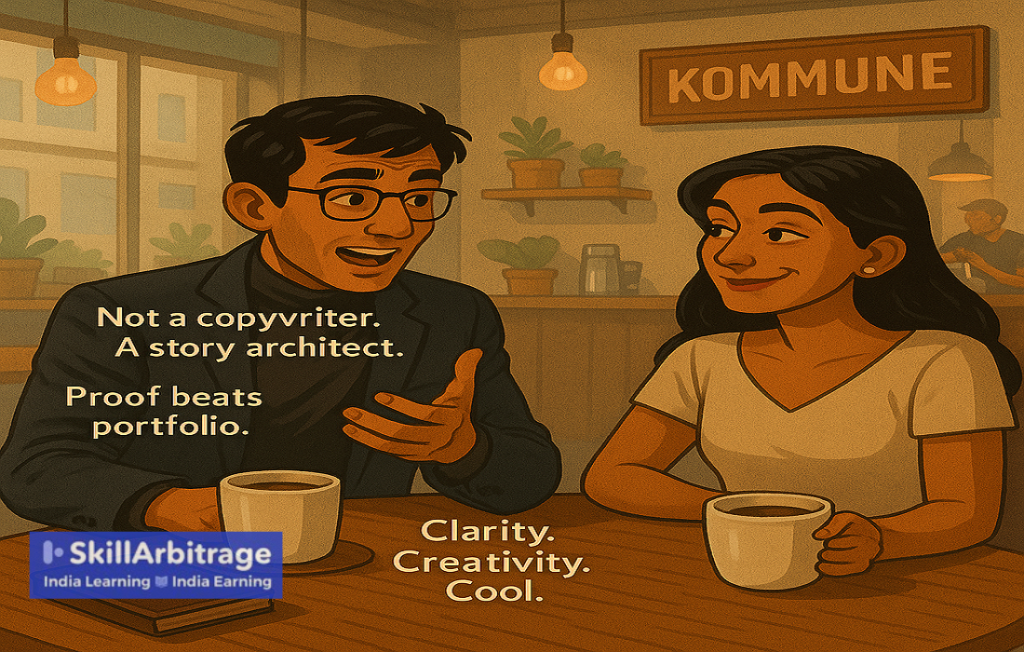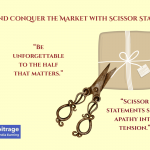This article is a complete blueprint for transforming from a freelancer to a high-value consultant. It synthesizes the key strategies from the previous four articles, focusing on building a distinct personal brand, proving your impact, mastering client acquisition, and positioning yourself as a results-driven expert. It emphasizes creating visible, lasting value that attracts clients naturally, rather than endlessly chasing them.
Table of Contents
Previously on Human Edge…
Under the guidance of his mentor, Parvathishankar, Raja learned how to position himself strategically and leverage his unique skills to stand out in a competitive market.
Now, this is the culmination of all Raja’s lessons, distilled into actionable steps. Raja, now with a deeper understanding, explains everything he has learned to his date, Savitha.
(Continued…)
They met on Hinge the day before. No long chats, no endless banter. Just a short exchange, a spark, and then a plan: 7 PM at Kommune, a bar that looked like it had been decorated by someone who collected jazz records and heartbreaks.
Raja arrived early, overdressed. Dark turtleneck. Clean blazer. Just enough cologne to suggest he cared, not enough to seem desperate. He sat near the bookshelf, eyeing a dog-eared copy of Norwegian Wood like it might teach him what to say.
Then she walked in. Savitha. Savitha Nair.
She wasn’t flashy, but she had presence. The kind of confidence that doesn’t shout. A linen dress. Eyes that scanned, assessed, and absorbed. The kind of girl you instinctively want to impress and instantly forget how.
He stood up too fast. Their hug was more of a polite press of shoulders. Half a second too long.
She smiled.
“So… you’re real.”
Raja laughed nervously.
“Yeah, I mean, I try to be. In general.”
Then silence. He reached for his glass of water, missed slightly, and knocked the coaster instead.
“You’re really pretty,” he said, too quickly.
“Sorry. That sounded like I’ve never seen a girl before. I have. Just… not like this.”
She laughed, not unkindly.
“We just matched yesterday. You really believe in fast action, huh?”
“I read somewhere that momentum dies in 24 hours. Or maybe I made that up. Either way, it felt right.”
She tilted her head.
“Do you always talk like Alex Hormozi?”
“Only when I’m nervous. Or thinking too hard. Or trying to sound smarter than I am. So… basically, yes.”
She smiled again and scanned the room. Jazz hummed in the background. Someone behind the bar opened a bottle of wine with a soft pop. Raja took a breath, preparing to say something clever.
He leaned forward slightly, elbows grazing the edge of the table.
In his head, he quickly rehearsed a dozen ways to say what he did without sounding like a cliché.
“So, what do you do?” he asked, hoping to buy time before she turned the question back on him.
“I’m in marketing,” she said, swirling her glass. “Brand side. D2C skincare startup. Small team. Lots of chaos. I write copy sometimes, but mostly I argue with founders about deadlines.”
Raja nodded like he understood. He didn’t. Not really.
“Oh, that sounds…”
He paused.
“…familiar.”
She raised an eyebrow.
“You freelance?”
His brain short-circuited. That word. That damn word.
Freelance? Like a temp? Like someone waiting between jobs?
He panicked.
“Something like that.”
“Copywriter?”
He hesitated. The word felt… insufficient.
“More like brand strategy. Story architecture. Emotional clarity. Stuff like that.”
Savita swirled her wine like it had secrets.
“Emotional clarity? That sounds… fluffy.”
Raja leaned forward, eyes lighting up.
Level 1: Brand-building framework
Core identity
What the brand believes, who it’s for, and why it exists beyond the product.
They had barely made it past small talk. And now she’d said it—“Copywriter?”—like someone asking if you still use Hotmail.
Raja bristled, then leaned forward like he was about to confess a cult membership.
“I’m not a ‘copywriter.’ That’s like calling a therapist a ‘listener.’ I help brands design writing rituals.”
Savita blinked.
“Okay… what does that mean?”
Title isn’t the offering
“It means the product is never the real product,” he said. “Products are fine. But what do they unlock? That’s what I sell.”
Convictions, not decoration
“If your brand doesn’t have convictions,” he said, “it’s just decoration. Even your refund policy should whisper the same truth—We’re not for everyone.”
She half-laughed, then stopped. She was listening now.
Own the experience, not just the features
“No one owns eco-friendly. But guided prompts that pull trauma out gently? Harder to copy.”
He tapped the coaster like it was a mic.
“Differentiation isn’t what you make. It’s the experience you design.”
Speak to a person, not a demographic
“And I don’t write for ‘millennials who like self-care,’” he added, waving the idea off like smoke.
“I write for Priya. 31. Management consultant. Journals with her eyes closed because her dad used to mock her handwriting.”
Savita stared. “That’s… oddly specific.”
He grinned. “That’s the point.”
Transformation is the product
Then, solemnly:
“Problem. Solution. Outcome.
Before: Can’t write a sentence without spiraling.
After: Two pages in, clarity lands like an old friend.”
Savita raised her wine to her lips and muttered, “Jesus Christ.”
Raja beamed. “Close. But just Raja.”
Brand voice & message
How the brand speaks. The tone, the rhythm, the language of trust.
She eyed him like he might start levitating.
“You know, you talk like this is some spiritual awakening.”
“It kind of is,” he said, with a maddening calm.
3 V’s: Vibe, vocabulary, values
“Every brand voice has three moving parts: Vibe, Vocabulary, Values.
Vibe is the emotional texture—poetic or practical?
Vocabulary—do you say ‘ritual’ or ‘hack’? ‘Soft’ or ‘gentle’?
Values—if you believe stillness is power, your copy should never rush.”
Jazz sax crooned softly behind them like punctuation.
Slogan is a spine, not a soundbite
“Most people chase slogans,” he said. “Catchy crap. But real brands? They need spines.”
Savita smirked. “Slogan with scoliosis?”
“Exactly. Most are just decoration. But a spine holds the whole damn thing up.”
One-liner rule
She squinted. “Alright then. What’s your one-liner?”
He didn’t even blink.
“Clarity. Creativity. Cool.”
She raised an eyebrow. “That’s rehearsed.”
“Tested,” he corrected. “On clients. On strangers. On myself.”
Voice playbook = Consistency kit
“And when I write your voice,” he said, “you get a tone slider. A banned words list. Even a ‘2 AM drunk text’ version of your brand.”
She almost spit out her wine.
“Wait…what would that sound like?”
He paused, eyes soft.
“Still warm. Still soft. Still here.”
She stared.
Then looked away.
“Okay. That one got me.”
Activation & execution
How the brand comes alive in offers, content, and conversions.
Savita set her glass down. “So you do all this… and then what? Clients just line up?”
He shook his head.
“You don’t chase clients. You activate moments.”
Outcomes, not products
“My friend Anjali was selling journals for ₹799,” he said. “I renamed it The Mindful Writing Kit.
Added a wax-sealed letter. A ritual guide. A playlist for writing at dawn.”
“Same journal,” he added, “completely different response.”
Transformation stories = Real UGC
“And people didn’t post ‘Got my journal!’ They posted,
‘Wrote something honest for the first time in months. Cried. Felt lighter.’”
He grinned. “That’s not user-generated content. That’s testimony.”
Positioning beyond copywriting
She narrowed her eyes. “You sound like a cult leader.”
He shrugged. “I’m the guy brands call when they’re tired of sounding forgettable.”
The jazz grew a little louder. Someone at another table laughed. The moment felt slow, a little charged.
She picked up her phone and typed something under the table.
To: Ananya
He is unhinged. Like a manic pixie dream marketer. But I think I want to hire him?
They had moved on to their second glass of wine. The playlist had shifted to Coltrane. The waiter had stopped hovering. The date had slipped into that strange middle place between interview and improv theatre.
Savitha rested her elbow on the table, chin on her palm.
“So what do you do when you’re not turning journals into confession machines?”
Raja squinted.
“You mean when I’m not trying to romanticize paper cuts?”
She chuckled. “Yeah. Like, how do you… show what you do? Do you have a portfolio or something?”
He grimaced, then recovered. “Sort of. But honestly, portfolios are… misleading.”
“How?”
“They show effort. Not impact. Clients don’t care that you tried really hard. They want to see something changed.”
Savitha raised an eyebrow. “So… you just expect people to take your word for it?”
“No,” he said, sitting straighter. “I just don’t wait for some big-ass win before I start showing proof.”
Level 2: Make it visible through proof
(Not potential. Not effort. Proof.)
Don’t wait for big wins.
Even small work – unpaid, hobby, or accidental can carry weight if you show the before and after. Raja reached into his bag and pulled out his phone.
“See this? I helped a friend rebrand her tiny journaling blog last year. Just four posts and a voice revamp. Nothing major.”
Savitha scrolled. “So?”
“Now she’s running workshops. Booked out. People say it feels like therapy without the therapist. That shift? That’s my work. Doesn’t matter that it wasn’t paid.”
She looked up, skeptical. “You really think that’s enough?”
“If you show what changed,” he said, “it’s more than enough.”
Proof beats portfolio.
“Most people say, ‘Here’s my work.’ I say, ‘Here’s what changed because of me.’”
Savitha rested her glass. “That’s catchy. But do you, like, write this out somewhere?”
Raja nodded. “Case studies. 1-pagers. Clean, sharp. Problem → Insight → Action → Outcome.”
She blinked. “You sound like a consultant. Not a freelancer.”
“Exactly,” he said. “Consultants don’t beg for attention. They create proof gravity.”
She leaned back, legs crossed now. “Alright. Give me the steps. What would you tell someone who has nothing but messy Google Docs and a couple of decent DMs?”
Raja didn’t miss a beat.
Frame the invisible
“You audit your past work through three filters,” he said, ticking them off.
“1. What problem did I solve?
2. What thinking did I apply?
3. What changed because of me?”
“Even if it was helping your cousin fix her Etsy store bio, you dig until you find value. Most proof is buried under memory loss.”
Savitha blinked. “That’s kind of beautiful.”
“I know. It’s annoying.”
Turn it into tangible assets
1. One-pager case studies
“Strip it down. One page. That’s it. Don’t write a memoir. Problem, Insight, Action, Outcome.”
He took a sip. “If they want more, let them ask.”
2. Proof-driven portfolios
“Fueler. Journo Portfolio. Contra. Don’t just show writing, show screenshots, client messages, and Looms walking through your thinking. Make it Googleable.”
Savitha interrupted. “Looms?”
He nodded. “Screen recordings. Show your thought process. Clients want to see your brain, not just your hands.”
3. Narrate your thinking publicly
“You take one of those case studies and turn it into a story.”
She narrowed her eyes. “Like a blog?”
“Better. A post. On LinkedIn. On Twitter. On Medium. Something like:
‘What I learned turning a skincare brand’s abandoned blog into their highest traffic source in 3 weeks.’”
Her eyes sparkled. “That’s sexy.”
Raja grinned. “You should see the headlines I don’t use.”
Midway through his story about turning a dead blog into a lead magnet, Savitha sneaked a glance at her phone and typed under the table.
To: Ananya
I asked “what do you do,” and now I know how Gatorade builds trust. This is… a lot.
4. Repurpose for client platforms
“Upwork, Fiverr Pro, Toptal… Wherever you apply, don’t say, ‘Here’s my portfolio.’ Say, ‘Here’s what changed because of me.’”
Savitha’s voice dropped half an octave. “You say that a lot.”
“It’s because no one else does.”
5. Optional add-on: Public risk-reversal offer
She leaned in. “Okay, say I’m a client. What would you offer me to take a chance on you?”
Raja smiled.
“I’d say:
‘I’ll do for your brand what I did for hers. If it works, we work together. If not, you keep the strategy free.’”
Savitha sat back slowly, considering.
“That’s bold.”
“That’s visibility,” he replied. “It flips the switch from Who are you? to What if he’s right?”
She laughed, almost in spite of herself. “You’re absurd.”
“But persuasive,” he said.
She raised her glass again. “Tragically, yes.”
They clinked.
The wine didn’t taste any better.
But the night was starting to.
Level 3: Get an edge against AI & cheap freelancers
→ Offer irreplaceable human insight, micro-productize services, and shift the pricing conversation
The waiter refilled their wine, trying not to look bored. Raja hadn’t touched his drink. He was too busy gesturing like a man possessed. Savita rested her chin on her hand. Somewhere between fascinated and deeply concerned.
“You ever wonder why so many freelancers sound the same?” he asked, barely pausing.
“They use the same Canva carousels. Same hook formulas. Same ‘I help X do Y’ bios. It’s like a factory of slightly different robots screaming into the void.”
Savita raised an eyebrow. “So what makes you different? You don’t use Canva?”
“I don’t pitch copy,” he said, sitting back dramatically. “I pitch clarity with consequences.”
She blinked. “That means nothing.”
He grinned. “Until I unpack it.”
He leaned forward again, his voice dropping slightly. Like he was about to tell her a secret.
Tactic 1: Show what AI can’t replace
→ Insight. Taste. Judgment.
→ Connect personal memory to business context
“AI can write. But it can’t notice. Not like we do.
Last week, I was talking to a skincare brand. Founder says: ‘Our copy’s fine. ChatGPT did it.’
So I ask her: ‘What smell reminds you of your mother?’
She says: ‘Wild lemongrass. We had a soap bar growing up.’
I told her that’s your new tagline: ‘Smells like home, not chemicals.’
Suddenly, the copy wasn’t about ingredients. It was about childhood.
That’s what AI misses. That flicker behind the words. The ghost in the product.”
Savita swirled her glass, slower now. “So you just extract people’s trauma and monetize it?”
“Only if they consent,” he said, deadpan.
As Raja warned her about the age of “AI clones and commodity copy.” Savitha picked up her phone slowly, not to miss anything.
To: Ananya
He said “Algorithms can guess your mood but not your memory.”
Okay that was… kinda sharp??
Tactic 2: Micro-productize
→ Package your method as a named system
→ Teach the transformation, not just the task
“I don’t sell writing. I sell Clarity Kits.
Each one has a ‘Story Stripdown’ session, a ‘Voice Spine’ doc, and a ‘Messaging Map’.
Clients don’t ask, ‘How many words?’ They ask, ‘Will this help us stop sounding generic?’”
Savita tapped her nail against her glass. “So you’re a copywriter who refuses to say he’s a copywriter?”
“I’m a mirror with better vocabulary,” he said. “And a naming fetish.”
Tactic 3: Shift the pricing conversation
→ Price by clarity created, not content delivered
→ Use “Before/After” language to anchor value
“Cheap freelancers charge per word. I charge per revelation.
Before: scattered, stuttering, unsure.
After: Oh damn, that’s us. That’s exactly what we were trying to say.
That shift? That’s what I price.
I’m not a line item. I’m a before/after generator.”
Savita looked at him for a long second.
“You ever just… say something normal?”
He paused. Blinked. “Like what?”
She laughed. “I don’t know. Talk about the weather or something.”
Raja glanced out the window.
“It’s a good night for breakthroughs.”
She groaned and knocked back the rest of her wine.
“God help me, I’m actually curious about Level 4.”
Raja smiled like he’d just been handed the mic at his own TED Talk.
“Buckle up.”
Level 4: Get US clients
→ Pass the Speed, Familiarity, and Risk filters with precise positioning and frictionless pitching
The waiter had stopped checking in. The jazz had shifted to a slower, smokier groove. Savita’s phone buzzed once, and she ignored it. Raja was mid-rant again, hands in motion like he was conducting a seminar that nobody asked for but couldn’t look away from.
“Okay,” she said, smirking. “Hit me with it. How does your poetic little clarity business get clients who pay in dollars?”
Raja smiled like she’d said the magic words.
“It’s not just about sounding smart. Or making pretty decks. It’s about removing every reason not to hire you.”
She leaned back. “Go on.”
Tactic 1: Speed filter
→ Most freelancers lose the project because they make hiring them hard
“You ever try to book a freelancer and they say, ‘Let’s jump on a call’… four days later?”
Savita nodded. “Every time.”
“That’s where they lose. Clients don’t want meetings. They want momentum.
So I built a Decision Page.
One link. All my work. 2-minute video pitch. Case studies. Testimonials. Offer breakdown. Pricing ballpark.
Everything they need to say: Yeah, let’s go.”
He paused for effect. “I don’t wait to get chosen. I make it impossible not to.”
Savita raised a brow. “What’s in the video?”
“Me, telling them how I’d solve their problem. With examples. With skin in the game. Not a pitch. A preview.”
Tactic 2: Familiarity filter
→ Clients hire people who already “speak their industry”
“I used to pitch everyone. Fashion, SaaS, wellness. Now? Just D2C founders.
I send them something that sounds like them, looks like their site, but hits harder.
They don’t ask for my resume. They reply with: ‘How soon can you start?’”
She tilted her head. “So you become their ghost?”
“I become their reflection. But better dressed.”
Savitha texted without looking down.
To: Ananya
He just said “Passing the familiarity filter is hotter than abs.”
Don’t laugh. I think I’m sold.
Tactic 3: Risk filter
→ Clients want outcomes they can point to, not writing they have to ‘hope’ works
“No one wants to test a freelancer. They want to hire a result.
So I use what I call a Proof Stack.
Start with:
— The ‘Before–After’ rewrites
— Screenshots of client Slack messages (‘This is GOLD 🔥’)
— Metrics when available (‘Open rate jumped from 22% to 48%’)
— And then… my favorite: the client quote that says, ‘This felt like you read my mind.’”
Savita narrowed her eyes. “You’re really out here selling telepathy.”
He nodded. “Telepathy as a service. TAAS.”
She chuckled. “So what happens when they say, ‘We love it, but can you do it cheaper?’”
He shrugged. “I say: If you want cheap, you’ll find someone fast. If you want unforgettable, you already have.”
Silence settled between them for a moment. Not awkward. Just… full.
She looked at him, maybe seeing past the dramatics now.
“You actually built all this?”
He nodded.
“You always talk like this?”
He hesitated. Then:
“No. Just when it matters.”
She smiled. Not indulgent this time. Not amused.
Just… something softer.
She raised her glass. “To your tiny TED Talk.”
He clinked it lightly. “To your dangerous curiosity.”
And for once, Raja didn’t say anything clever.
Just drank.
Savita glanced at her phone one last time.
To: Ananya
He pitched a whole brand strategy. Accidentally. Kinda want to hire him tho.
She held up the napkin on which Raja had scribbled the three hiring filters like a prized blueprint.
“You missed one,” she said, taking a photo.
“What?”
“Charm.”
Her phone buzzed. A reminder: Early client call tomorrow.
She sighed, finishing the last sip of her wine.
“I should go. Real world calls.”
Then, softer:
“This was… surprisingly not terrible.”
She pocketed the napkin and walked out.
He watched the door swing shut, still holding his wine, wondering if that was flirtation or feedback, a maybe or a yes dressed like a smile.
About last night.
Raja woke up late the next morning to a message from Savitha.
“Office at 4? My boss wants to meet the guy who thought a date was a brand workshop.”
He blinked.
Smiled.
And started ironing a shirt.







 Allow notifications
Allow notifications
